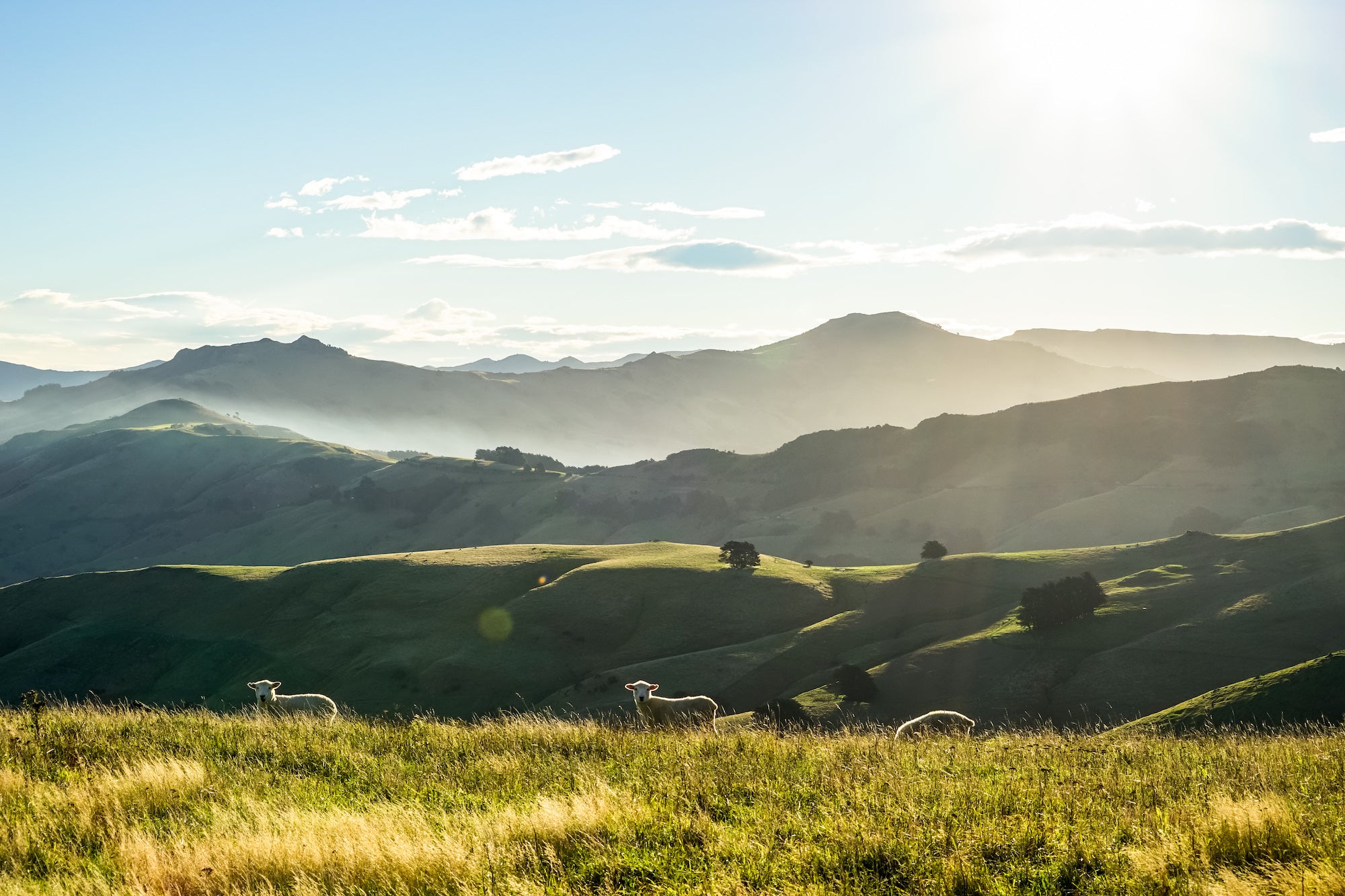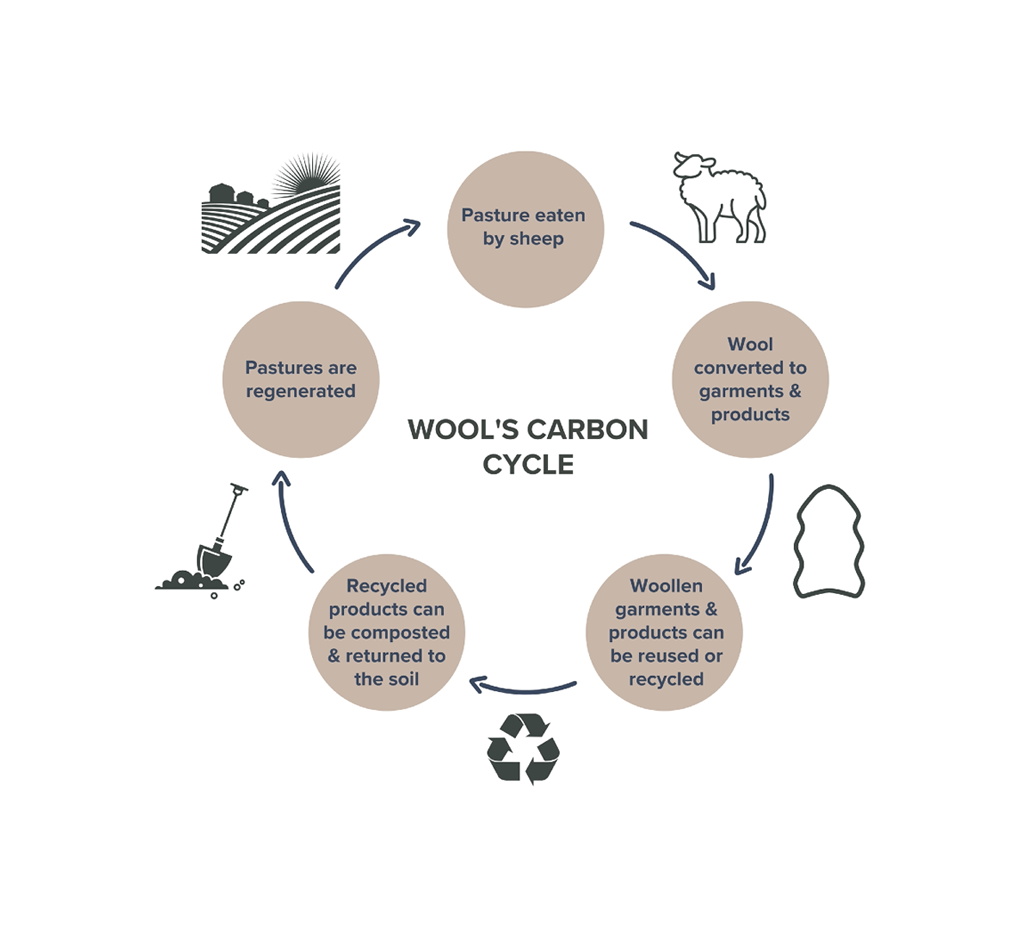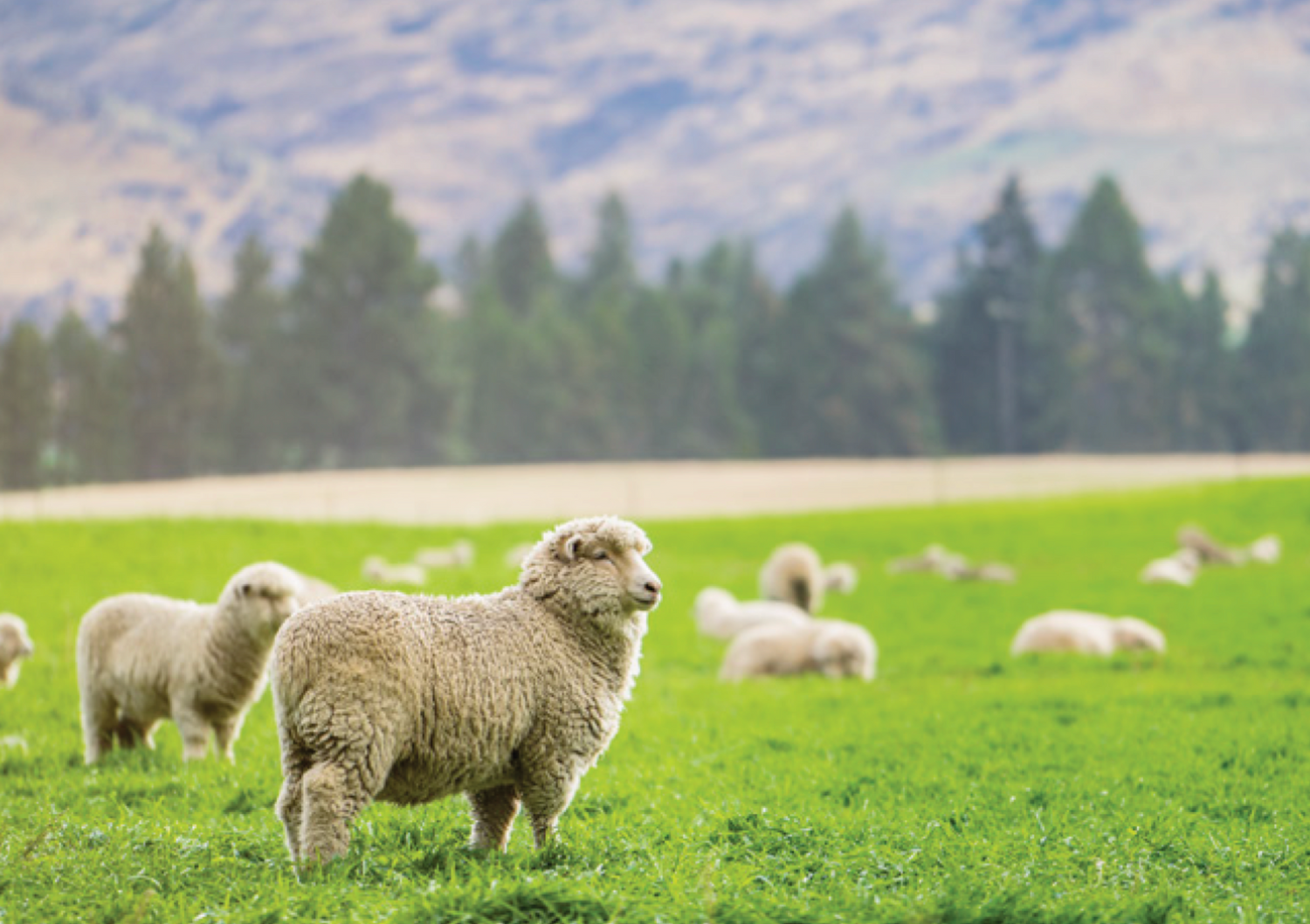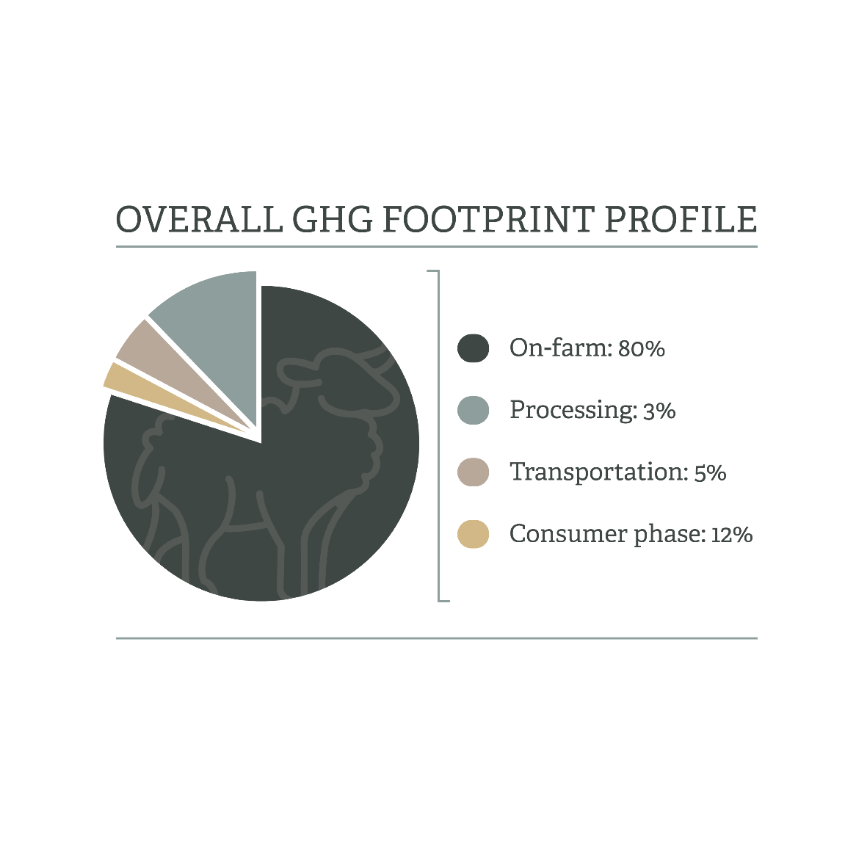
The Environment
Solutions for a Greener Future
We believe that wool is one of nature’s brilliant solutions for a greener future. We wholeheartedly embrace the intrinsic qualities of sheepskin that can help pave the way towards that vision. We continuously assess every facet of our supply chain, striving to deliver products that not only boast exquisite beauty, safety, and impeccable design, but also leave only the most minimal of marks on our cherished natural environment. Our commitment is genuine, driven by our unwavering passion for the environment and a desire to make a positive difference.
Micro Plastics, Macro Concerns
Microplastic pollution stands as a paramount and pressing challenge for the world’s textile industry.
“All synthetic clothing and materials, sooner or later, will become microplastics, a “time-delayed” pollution bomb. ... The problem with synthetic fibres is that they will never biodegrade, but just keep breaking down into smaller and smaller pieces. Every piece of plastic ever made is still in existence.”
Microfibres can come in two varieties: natural or synthetic. When we talk about synthetic microfibres, they have a tendency to gradually break down into tiny fragments over time. Once these fragments measure 5mm (about 3/16 of an inch) or less, they are commonly referred to as microplastics.
When it comes to polyester fabrics, scientific studies have revealed an interesting fact: a regular 5 kg wash
load of polyester garments can set free a staggering number of about 6 million microplastic fibres. It’s quite
surprising! It is estimated that there are 1.4 million trillion microfibres in the ocean, a number extrapolated by George Leonard, Chief Scientist for The Ocean Conservancy, based on the findings from this study: Ingested plastic transfers hazardous chemicals to fish and induces hepatic stress.
Scientific Reports (nature.com)
Microplastics have been discovered in freshly fallen snow in Antarctica, marking the first time this
contamination has been found in such a pristine environment. Researchers from New Zealand found tiny plastic particles, smaller than a grain of rice, in 19 snow samples collected from the Ross Ice Shelf. This finding raises concerns about the accelerated melting of snow and ice, posing a threat to the unique ecosystems of the continent.
Previous studies had identified microplastics in the ice of the Antarctic Sea and surface water, but this is the first report of their presence in newly fallen snow. The research, led by University of Canterbury PhD student Alex Aves under the supervision of Dr Laura Revell, highlights the alarming extent of plastic pollution reaching even the most remote regions of the world. The average concentration of microplastic particles in melted snow was found to be higher than marine concentrations in the surrounding Ross Sea and Antarctic Sea ice.
The most common type of plastic detected was PET. The study suggests that the microplastics may have travelled long distances through the atmosphere or that their presence in Antarctica could be attributed to human activity in the region. The discovery of microplastics in Antarctic snow underscores the urgent need to address plastic pollution, as these particles can have detrimental effects on both animals and plants. Further research is required to fully understand the impacts of this contamination, but the current knowledge suggests a cause for concern.
What then - sets wool apart?
Wool products and garments also shed fibres during wear and care, but there’s a crucial difference that
makes wool truly unique. Wool fibres have a natural ability to biodegrade.
Wool is composed of keratin, which is a protein - just like human hair. Unlike plastic, wool doesn’t break down into an ever-increasing amount of tiny plastic particles. Instead, wool fibres, when in the ground or water, undergo biodegradation as they get consumed by fungi and other microorganisms.
The research is crystal clear on this point: wool biodegrades safely. The rate at which wool biodegrades may
vary depending on factors such as the environmental conditions, whether it’s in soil or water.
So, you can trust that wool plays its part in being environmentally friendly and sustainable. It’s nature’s way of offering a smart solution to the microfibre challenge.

Wool’s Carbon Cycle: Harnessing Nature’s Sustainable Fibre
Just like all life on Earth, sheep and their wool are an integral part of our planet’s natural carbon cycle. Sheep and wool play a significant role in the carbon cycle as they represent biogenic carbon. This means that the carbon found in sheep and wool is part of the natural cycle, originating from living matter that has absorbed carbon throughout its life. In fact, around 50% of the weight of clean wool consists of pure biogenic carbon. On the other hand, emissions from fossilised carbon lie at the core of the global warming crisis.

Sheepskin: The Endurer
As a sheepskin manufacturer and distributor, one of our most significant accomplishments lies in our ability to divert waste from landfills and transform it into something truly remarkable and enduring. This story holds immense importance, and we take pride in sharing it. By processing and allowing the repurpose of sheepskin that would otherwise end up in landfills, we breathe new life into it, giving it purpose and beauty. Every sheepskin we work with carries a unique tale of sustainability and resourcefulness. We embrace the opportunity to create something valuable and exquisite from what is a by-product of the food industry and might have otherwise ended up in a landfill. When you choose our sheepskin products, you become a part of this story—a story that celebrates ingenuity and the creation of extraordinary items from what would have been discarded.

It’s important to note that while greenhouse gases are emitted from sheep, farmers worldwide have the power to influence the natural carbon cycle through their practices. By managing animals and pastures responsibly, they can have a direct impact on the amount of carbon stored in plants and soils, mitigating climate change.
As a by-product of the food industry, our New Zealand sheepskins are an inevitable part of the larger story. A recent study*, on behalf of the New Zealand agriculture industry, examined the greenhouse gas emissions across the lamb supply chain.
It was found that the estimated carbon footprint for a 100g serving of lamb is 1.9kg CO2 equivalents, with breakdowns as follows:
On-farm: 80%
Processing: 3%
Transportation: 5%
Consumer phase: 12%
Comparatively, driving a 2-litre car 10km would also produce about 1.9kg of CO2 emissions. These results align with expectations and similar global studies on farmed livestock products.
* For the study, AgResearch used the Life Cycle Assessment (LCA) approach which is consistent with the PAS2050 published standards for greenhouse gas foot printing. Life Cycle Assessment seeks to examine the impacts of a product – from production to consumption. On-farm emissions analysis completed for the study is consistent with New Zealand’s greenhouse gas (GHG) accounting methodology as submitted under the United Nations Framework Convention on Climate Change (UNFCCC) and is based on the average New Zealand sheep farm. The lead author of the study, Dr Stewart Ledgard, is now leading an international group of scientists for the UN FAO to establish a global GHG foot printing methodology for pastoral livestock systems.
Towards Carbon Neutrality: New Zealand's Green Commitment
The New Zealand lamb and beef industry is also actively working to understand its environmental impact and make improvements.
As Kaitiaki (guardians) of the environment, New Zealand farmers take their responsibilities seriously, from protecting waterways to achieving carbon neutrality. Farmers have a deep connection to their land and animals, and they strive to leave their farms in better shape for future generations. Kaitiakitanga, or guardianship, is an active practice that requires everyone to contribute to the well-being of the climate, land, and water. When nature flourishes, families, communities, and businesses thrive too. While they’re already doing a lot to care for our natural environment, there’s always room for improvement.
The industry’s sustainability approach, guided by the United Nations’ Sustainable Development Goals (SDGs), focuses on people, planet, and prosperity. It brings together economic, social, and environmental aspects. Through their extensive Environment Strategy, they have set out a long-term vision for the sector, emphasising four key priorities: healthy productive soils, thriving biodiversity, reduced carbon emissions, and cleaner water. The primary focus for reducing the sheep’s carbon footprint is on the farms, with significant investment in research in this area.
• Originally, the goal for farmers in New Zealand was to increase meat production while simultaneously reducing the amount of pasture used. However, as a result of using fewer resources (pasture) and a smaller national sheep stock, the weight of meat produced has slightly decreased over the last 20 years. The reduction in pasture usage and the smaller sheep numbers have contributed to this outcome. The focus has most recently been on optimising efficiency and environmental sustainability, even if it means a slight decrease in the overall weight of meat produced. In other words, farmers are now able to produce roughly the same amount of meat while using fewer resources, resulting in a more efficient and environmentally friendly production process. The overall goal today is to continue to minimise the environmental impact while maintaining productivity and sustainability. Researchers estimate that this improvement has reduced New Zealand’s sheep farming carbon footprint by over 30% since 1990.
• Woody vegetation on NZ sheep and beef farms is offsetting between 63% and 118% of their on farm agricultural emissions according to a 2020 study.
• Farmers continue reducing carbon emissions, moving towards the goal of a carbon neutral sheep and beef sector by 2050.
• New Zealand sheep farmers are researching breeding “low methane” sheep:
This significant initiative addresses farmers’ priorities by reducing greenhouse gas (GHG) emissions and promoting healthier animals. Access to rams with the methane breeding value will be available within two years, contributing to lowering sheep methane emissions and the agricultural sector’s environmental impact. The group is also developing additional technologies to reduce methane generated by feed, compounding the positive influence on the national flock’s methane production.
• Research is well advanced in New Zealand to develop a vaccine for sheep and beef that could further reduce methane emissions by up to 20 percent in the industry.

Further initiatives are underway by the industry in New Zealand to further reduce sheep’s carbon footprint, including:
• Strategic large-scale research targeting livestock emissions.
• Meat processing initiatives involving improved waste-water treatment systems, energy efficiency programs, and exploring alternative fuels like wood chip and waste for boilers.
• Collaboration with individual shipping lines by meat exporters to identify methods for reducing the ocean-shipping component of the footprint (such as slow steaming).
• Educating consumers about energy-efficient purchasing, cooking, and storage methods.
• The New Zealand Government has committed to the Paris agreement, which was signed by 197 countries in 2016 and came into force in 2020. The agreement aims to limit global warming to less than 2.0oC and preferably 1.5oC. To achieve this, countries have committed to reducing all greenhouse gas (GHG) through nationally-determined contributions (NDC). New Zealand’s agricultural component is being driven via the recently-passed Zero Carbon Act.
• The New Zealand government has launched a One Billion Trees Fund that will complement the work already being done on sheep and beef farms to help offset the impact of farming emissions.
Sustainable Partnerships: Our New Zealand Supplier Initiatives
There is no single, quick fix solution to the issue, but at Fibre by Auskin, we understand that by partnering with quality and conscious suppliers in the industry, we can help minimise the carbon footprint – and it starts from the paddock.
Steps taken by our leading New Zealand suppliers to reduce environmental impact at their processing sites:
• Reducing on-site electricity consumption by 10.8% per kg processed.
• Decreasing on-site natural gas consumption by 11.3% per kg processed.
• Lowering on-site LPG and diesel consumption by 50.6% per kg processed.
• Achieved a 10.7% reduction in on-site energy consumption, equivalent to 23.2GWh per year at FY14 production rates.
• Cut on-site carbon emissions by 7.6% per kg processed, resulting in 10,140 tonnes of CO2 reduction per year.
Major projects implemented by our leading supplier that positively impacted emissions:
• Utilising waste heat for pre-heating water.
• Upgrading their hot water system.
• Refrigeration Heat recovery project.
• Our leading supply partner has additional projects planned and underway at various sites. The next phase aims to further reduce carbon emissions by 4,000 tonnes per year (2.9%) within the next two years.
From Fibre to Fertiliser: Wool’s Remarkable Biodegradation Story
One of the incredible sustainable qualities of wool lies in its ability to biodegrade. Wool is composed of keratin, the same protein found in human hair. Micro-organisms present in soil and water can break down wool fibres, initiating a continuous biological life cycle.
Tests have shown that wool products can nearly completely degrade within six months, when buried in the ground. Even in aquatic environments, wool exhibits biodegradation. Recent research conducted in New Zealand revealed that within 90 days, different types of wool had already biodegraded by approximately 20%. As wool biodegrades, it acts as a valuable soil conditioner and fertiliser, releasing essential elements like sulphur, nitrogen, phosphorous, and potassium.
These biodegradation properties of wool, stand in stark contrast to synthetic fibres, which take much longer to break down and often release harmful microplastics into the environment. Wool’s unique structure and water-repellent outer membrane contribute to the resilience and longevity of its fibres while being worn. The biodegradation of wool typically occurs in moist and warm conditions that typically come into play after the useful life of woollen products.
So, when you choose wool, you are embracing a historical fibre, a durable and long-lasting material, and contributing to a sustainable future. Wool’s ability to biodegrade in an environmentally friendly manner sets it apart from synthetic alternatives, making it a natural choice for conscious consumers.
